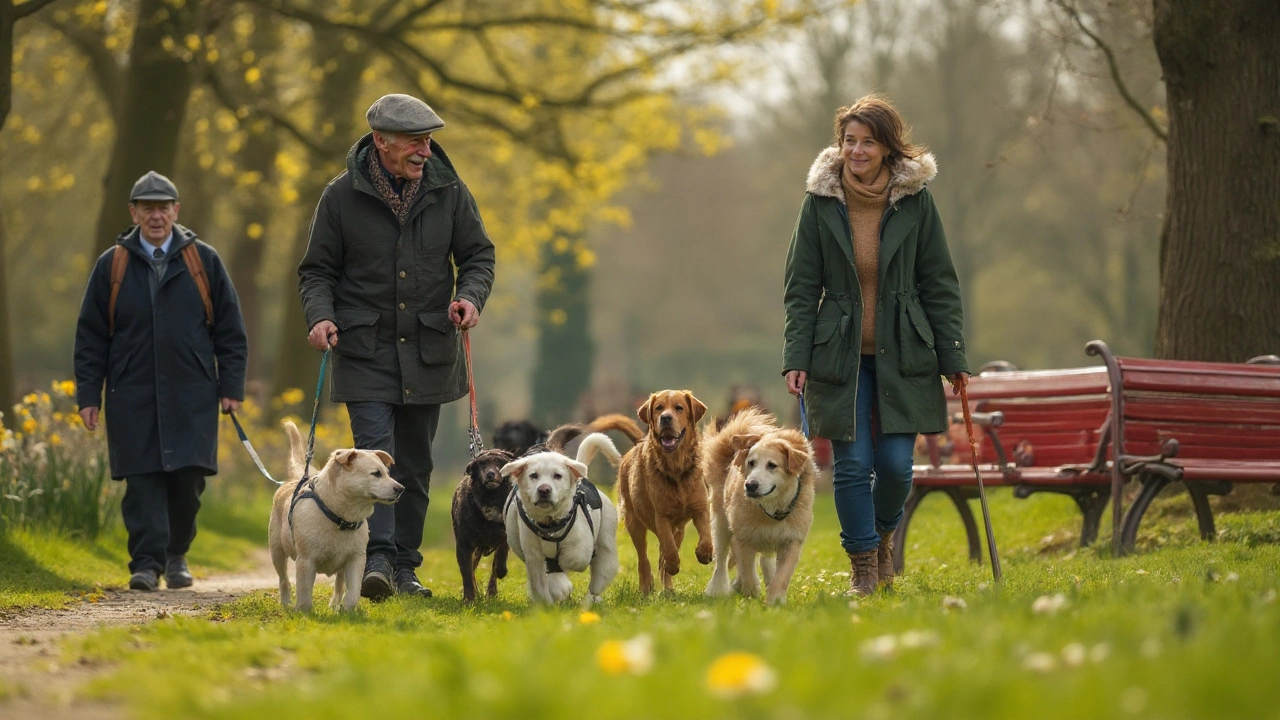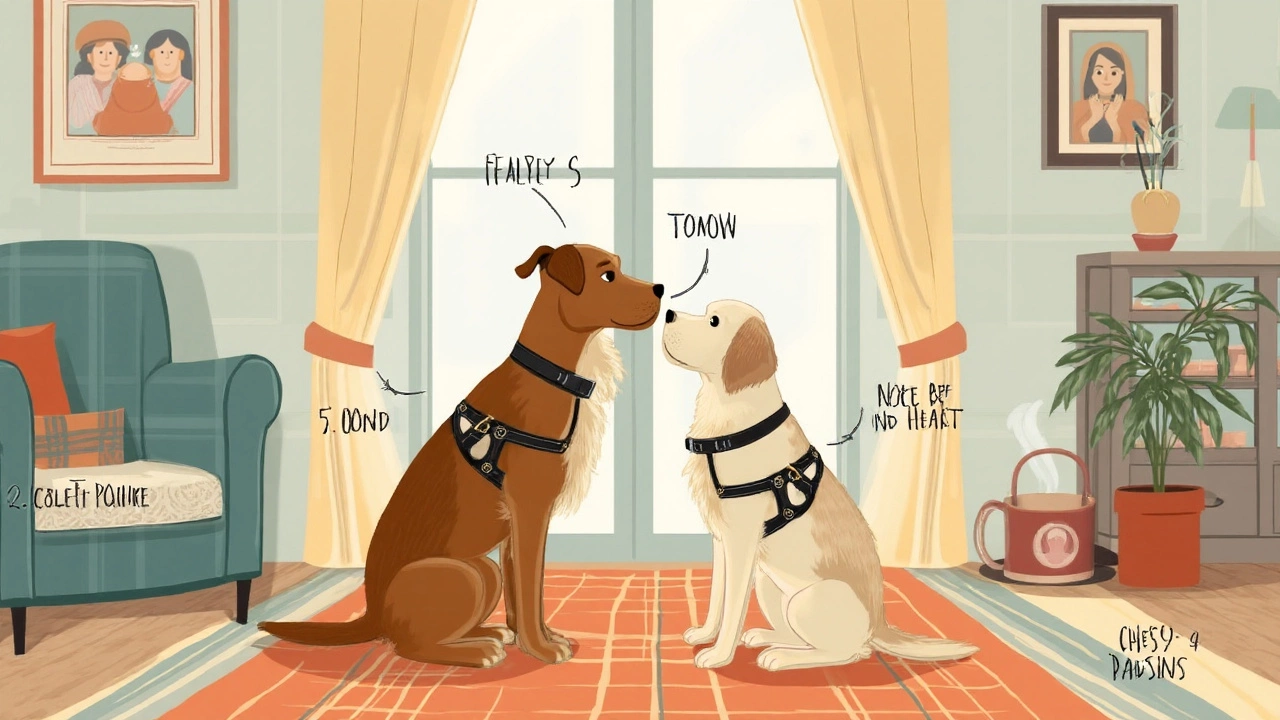The next time you’re out at Queen Square or strolling through Clifton Downs, take a look at the number of dogs wearing collars compared to harnesses. You’ll see a split crowd—hardcore collar fans and harness loyalists, each convinced their pick is best for their pooch. Dig a bit deeper, though, and you find this question is way more complicated than a simple team collar or team harness match. The real story? There’s science, vet opinions, and some pretty surprising facts that flip the common assumptions on their head.
What’s the Real Difference Between a Collar and a Harness?
Grab a classic collar—simple, fastens around your dog’s neck, holds an ID tag, and for decades, it’s been the go-to for walks or training. Easy, right? But here’s the curveball: collars put all the pressure right on a dog’s trachea and neck. Doesn’t sound like a big deal for a chilled-out old Labrador, maybe, but what if your dog’s a determined puller, a tiny breed, or one of the squishy-faced bulldogs or pugs? That’s where harnesses make a dramatic entrance.
Harnesses wrap around the chest and shoulders, so the force is spread out, away from that delicate neck area. Think of it like comparing carrying a bag using just your fingers versus slinging it across your back. A lot more comfortable, right? Plus, harnesses give you more control, especially with energetic, jumpy, or skittish dogs. You won’t end up choking your pet every time a squirrel dances past. And there’s less risk of them wriggling out of their gear entirely.
Does this mean collars are always bad? Not at all. Many dogs who walk calmly and don’t lunge or pull can safely use a collar. But if your canine’s style is more ‘tow truck’ than ‘chilled out pedestrian,’ most vets (and dog trainers, too) will nudge you towards the harness side of the aisle.
The British Veterinary Association (BVA) and the Royal Society for the Prevention of Cruelty to Animals (RSPCA) both warn that collars, when used routinely to restrain pulling, can cause damage over time. You get pressure on the throat, risk of tracheal collapse (especially in smaller breeds like Yorkshire terriers, Chihuahuas, or Pomeranians), and even increased pressure on the eyes for brachycephalic breeds. If your dog already has a cough or is known for pulling on the lead, a switch to a harness isn’t just about comfort—it can literally protect their health.
Now, not all harnesses are created equal. Some are soft, some have pads, and others are designed for car travel or running. A poorly fitted harness can rub under the armpits, restrict leg movement, or slip off if your pup backs up, so the right fit is key. One hack: you should be able to fit two fingers easily between the harness and your dog’s fur—snug but not tight.

Vet Recommendations: What Science and Experience Say
So what’s the official vet word? Most vets recommend a harness for daily walks, especially if:
- Your dog is a persistent puller or lunger
- You have a brachycephalic breed (bulldogs, pugs, Frenchies, boxers)
- Your pup is small, toy-sized, or has a history of tracheal or spinal issues
- It’s a puppy still learning to walk safely on a lead
The University of Bristol actually ran a study in 2023 on collars and harnesses. Their findings? Dogs walked using a harness had significantly less strain on their neck and showed lower stress indicators. Collars gave no trouble for calm, trained adult dogs, but as soon as excitement levels rose, the strain rocketed up—bad news for any dog with a delicate windpipe or a history of coughing.
Vet Paul Kelleher from the Long Ashton Vets team told the BBC last year, “We’re seeing more dogs with soft tissue damage around the neck, especially among flat-faced breeds and those who pull on the lead. Harnesses massively reduce the risk of injury, and for certain breeds, we’d consider them essential.”
An extra heads-up: harnesses aren’t a universal fix. Vets warn about ill-fitting harnesses that restrict shoulder movement, mess with your dog’s natural gait, or rub the skin raw. A Y-shaped front is a smart pick—it lets the shoulders move freely rather than forcing the legs into a weird angle.
If you’re big on recall, trainers still say collars have an advantage for ID purposes. Your dog’s tag (with your contact info and postcode, as required by the UK law) should always be attached to a collar—even if you’re using a harness to walk. That boosts the odds of your pup getting back to you if they go on an adventure you didn’t approve.
And then there are special cases. If your dog has a medical need—like spinal problems, arthritis, or is in post-op recovery—your vet might suggest a step-in harness, a support sling, or even a different lead system altogether. Makes sense to get a personalised recommendation, especially if your pup’s got quirky health issues.
One more vet-backed tip: introduce harnesses slowly, especially for nervous or rescue dogs. Start with a few minutes at a time, reward with treats, and go easy on the praise. Most dogs get the hang of a harness in just a few days.

Practical Tips for Choosing and Using Collars and Harnesses
No two dogs are the same, and their gear shouldn’t be, either. Picking the right harness or collar isn’t about what looks flashiest on Instagram—it’s about safety, fit, and lifestyle. Here’s what the experts and pro dog-walkers around Bristol swear by:
- Measure carefully. Every brand’s sizing is different, so grab a tape measure and check your dog’s chest and neck before ordering. Don’t guess. A wobbly harness is useless—and possibly dangerous.
- Test for freedom of movement. Your dog’s elbows shouldn’t be rubbing the harness when walking, and there should be no pressure on the trachea. Let your dog run, stretch, and roll with the harness on to see if it fits right in normal play.
- Look for reflective strips. Walking in British weather isn’t exactly always sunny, and reflective patches help drivers see you both at dusk or on dark mornings. This tiny feature has saved more than a few tails on a rainy Corn Street walk.
- Easy-to-clean material matters more than you think. Dogs find mud, water, and sometimes even fox poo. Nylon is light and dries fast, while leather (classic for collars) can last years if it stays dry, but starts to smell if it gets soaked.
- Try before you buy. If you can, head to a local pet shop and let your dog test out a few types alongside a canine professional. Staff at most Bristol pet supply shops know their stuff, and they’ll help sort out which style matches your dog’s unique vibe.
If you use a collar: make sure it’s snug, not tight—you should fit two fingers between the collar and your dog’s neck. Skip anything with hard decorative studs or heavy buckles that could dig in.
For harnesses: choose models with adjustable straps and minimal seams. Avoid the kind that squeeze the shoulder blades or drape too far behind the legs—those can lead to awkward posture and joint issues down the line. Many top UK trainers recommend the Perfect Fit or Julius-K9 range, but there are budget-friendly choices for every dog size, too.
A few myths to clear up: Harnesses don’t "teach" dogs to pull, but they might not fix pulling without training. You’ll still want to teach loose-lead walking—rewarding calm behaviour, switching direction if your dog charges ahead, and keeping the lead short but comfortable.
If you own a cat, by the way, the answer is simpler: vets are almost universally against collars for cats unless fitted with a quick-release safety clasp, as cats love to climb and collars easily get caught on branches or fences. Harnesses are safer for supervised outdoor time—plus, cats famously hate being controlled, so go gentle.
Don’t forget about supervision—no matter how pro your gear is, dogs shouldn’t be left tied up and unsupervised wearing harnesses, as straps can hook on furniture or branches. And if your dog has a history of skin irritation or allergies, be sure to choose hypoallergenic materials.
Once you find the right kit, your dog’s daily walks get safer and more enjoyable—and your neighbourly strolls through the harbourside can go from stress fest to tail-wagging good times. The harness vs. collar debate isn’t as black-and-white as Instagram reels make it look; it’s about real life, real dogs, and the unique quirks of every canine companion. There’s room for both options in your dog’s wardrobe—as long as you make health, comfort, and safety your top priorities.







